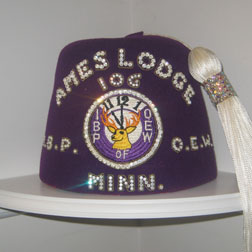Elk’s Lodge
Ames Lodge, Number 106 of the Improved Benevolent and Protective Order of the Elks of the World, was formed in 1906 and incorporated on August 1, 1907. This was a black organization based on but completely separate from the IBPOE. It went by other names, such as the Elks’ Rest, Elks Lodge, and the Black Elks.
The Elks Lodge has been located in several places over the years.
KISTLER BUILDING
Ames Lodge No. 106, Order of Elks, Improved Benevolent Protective Order of Elks of the World. This Lodge of the IBPOE was founded in October 1906. From June 1 , 1921, to November 4, 1922, ads in the Northwest Bulletin referred to the third floor as the Elks Hall, and the Minnesota Daily Star referred to it as the Colored Elks Hall. Dances were held three times a week and on holidays. By June 11, 1924 to at least 1925 it was called the Ames Lodge or the Elks Hall.
Curry’s Jazz Orchestra provided music for dancing on April 21, 1922.
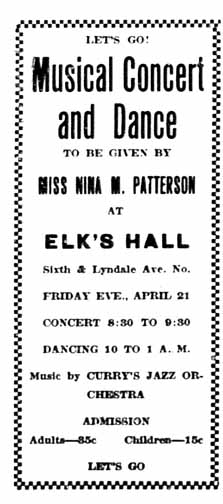
Northwest Bulletin, April 15, 1922
Bill Moore’s Jazz Orchestra led the dancers through the wild dances of the 1920s at this Emancipation Ball sponsored by a group called the Three Strutters.
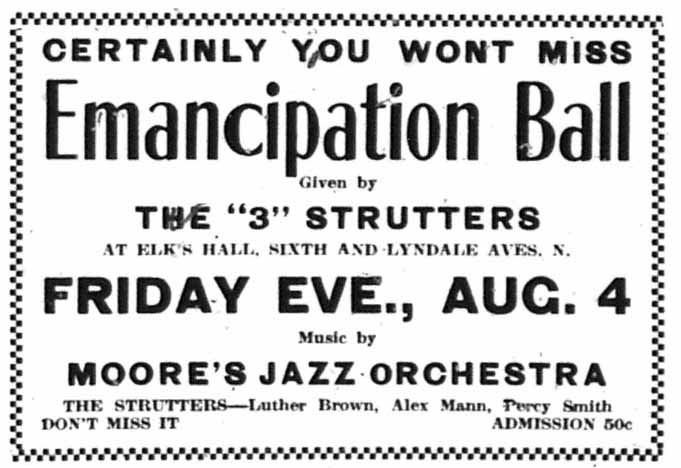
Northwest Bulletin, 1922
Bill Moore’s Jazz Orchestra was hugely popular in Minneapolis during these Roaring Twenties.
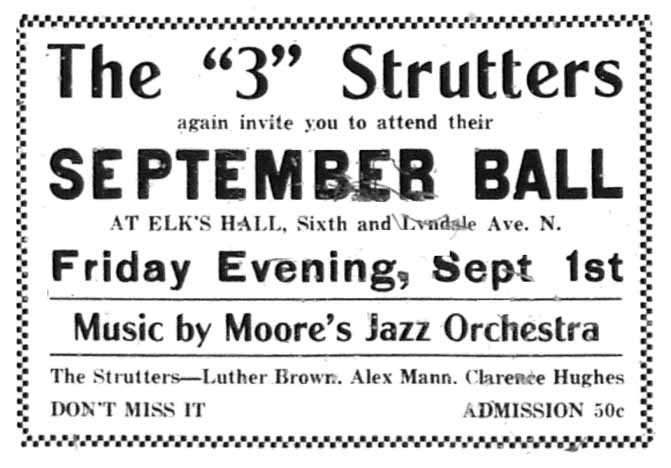
Northwest Bulletin, 1922
148 HIGHLAND
In about 1925, the Lodge moved to a large house at 148 Highland Ave., just off Sixth Ave. No. and Lyndale. The house was built in 1894 as a 17-room mansion on the edge of Oak Lake, which had since been filled in to become the municipal market. In March 1908, Dr. J.M. Kistler purchased “the Wilcox residence,” which was apparently run down, as he intended to make many repairs and live in the building. The purchase price was $7,500, well below the asking price of $9,000. The lot measured 150 feet on Highland Ave. and 150 feet on Lyndale.
Not long after the Lodge moved in in 1922, in June 1924, J.W. Moore applied for a dance hall license for the Ritz Cafe at 148 Highland, despite the protests of a local rabbi the month before. The rabbi was back in June, but was told that the police had closed the cafe for violation of the closing time ordinance and because the customers were noisy. (Minneapolis Tribune, June 4, 1924)
On April 18, 1933, just 11 days after it was legal, the Ames Lodge received a liquor license.
It was a black and tan music venue from at least 1934 to the late 1940s. Dances were held every Saturday night. Between bands Mrs. Meade would play piano.
In 1937 Ernest Saunders was the proprietor of the Elks Cafe in the building. An April 1937 article in the Minneapolis Spokesman said that J.W. Hutchcraft was the manager, replacing Edward L. Boyd. The article noted, “Hutchcraft is unusual in that it is impossible to tell whether he is Caucasian or Negro.”
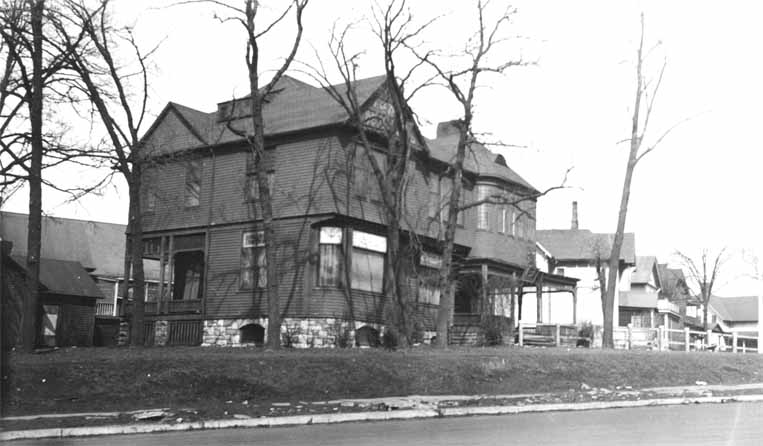
Photo taken March 29, 1937, courtesy Hennepin County Library, via Alan Slacter
Apparently one could either live at the building or stay for a night, presuming that you were an Elk.
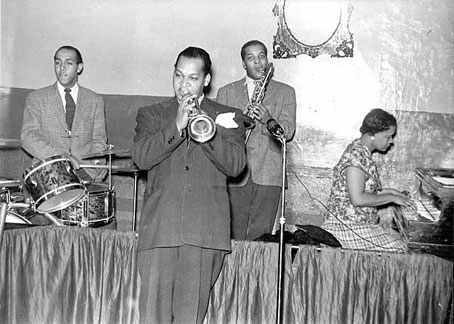
Entertainment at the Ames Lodge, 1950. Photo courtesy Minnesota Historical Society
The Ames Lodge Drum and Bugle Corps was a consistent crowd pleaser in Aquatennial and Winter Carnival parades, with their unique marching style and musicality. In the summer of 1951 they won the Grand Award in music and marching units at the Torchlight parade.
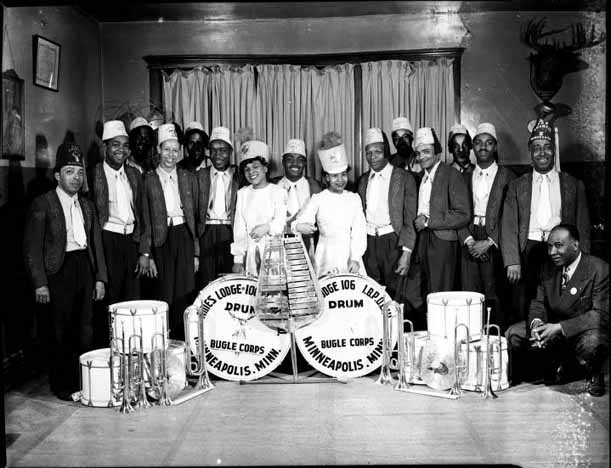
Drum & Bugle Corps, 1940s. Courtesy Hennepin County Library and the Children of John Glanton
In 1953 it was revealed by an undercover policeman that the Elks’ Rest was a transfer point for the delivery of heroin in the City. (Minneapolis Star, May 5, 1953)
148 Highland was torn down in April 1957 as part of the Glenwood Redevelopment Project.
1215 ALDRICH AVE NO.
The Elks relocated to another house at 1215 Aldrich Ave. No. That building was built in 1887 and was removed for highway construction in 1969.
1614 PLYMOUTH AVE. NO.
On July 7, 1968, ground was broken for the first new building on Plymouth Ave. since the $23 Million Near Northside Urban Renewal Program got underway the previous month. The Lodge building at 1614 Plymouth Ave. was expected to cost $38,000, and was being financed by First National Bank.
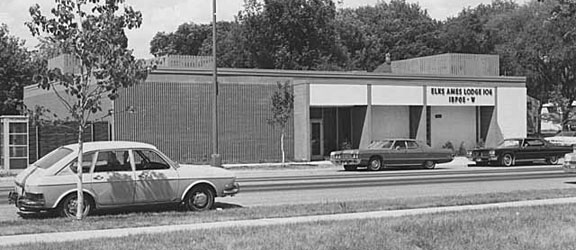
July 17, 1975 photo courtesy Minnesota Historical Society
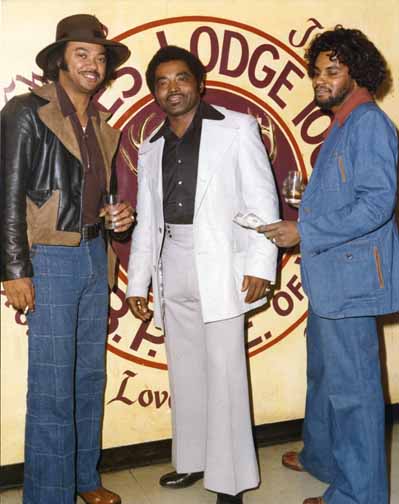
Photo by Charles Chambliss, courtesy Hennepin County Library – @ 1975 to 1985
As of August 2021, the Secretary of State’s website says that the status of the organization is “involuntarily inactive” as of early 2021, but that can be reversed.
Unbelievable luck led me to find the photo of the Ames Lodge fez online!
